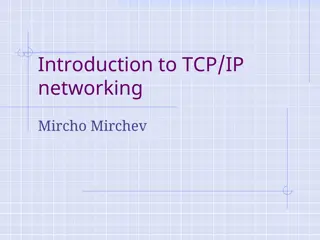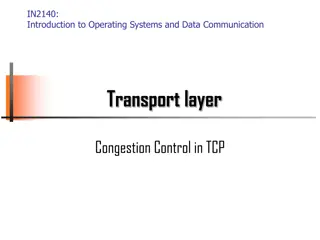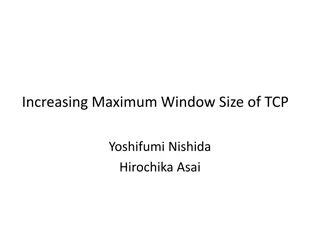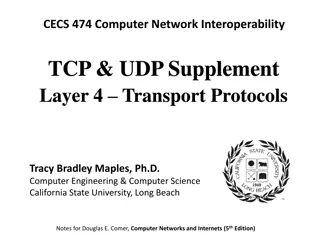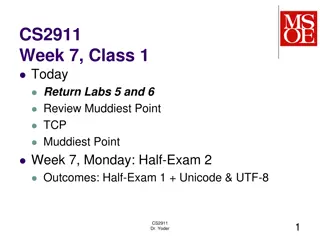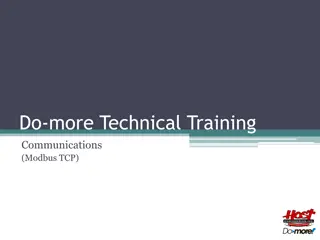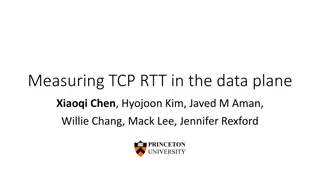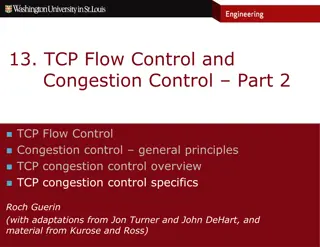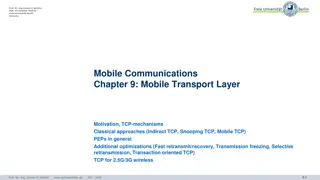Understanding TCP: Evolution, Features, and Operation
The lecture covers the Transport Layer focusing on Transmission Control Protocol (TCP). It discusses TCP's reliability, bi-directional byte streams, congestion control, flow control, connection setup, three-way handshake, connection tear-down, sequence number space, and bidirectional communication. TCP is explained in detail, including its features, functions, and operation for establishing connections and ensuring data delivery.
Download Presentation

Please find below an Image/Link to download the presentation.
The content on the website is provided AS IS for your information and personal use only. It may not be sold, licensed, or shared on other websites without obtaining consent from the author. Download presentation by click this link. If you encounter any issues during the download, it is possible that the publisher has removed the file from their server.
E N D
Presentation Transcript
Computer Networks Lecture 11: Transport Layer Based on slides from D. Choffnes Northeastern U. and P. Gill from StonyBrook University Revised Autumn 2015 by S. Laki
Outline 2 UDP already discussed TCP Congestion Control Evolution of TCP Problems with TCP
Transmission Control Protocol 3 Reliable, in-order, bi-directional byte streams Port numbers for demultiplexing Virtual circuits (connections) Flow control Congestion control, approximate fairness 0 Source Port Why these features? 4 16 31 Destination Port Sequence Number Acknowledgement Number Flags Checksum HLen Advertised Window Urgent Pointer Options
Connection Setup 4 Why do we need connection setup? To establish state on both hosts Most important state: sequence numbers Count the number of bytes that have been sent Initial value chosen at random Why? Important TCP flags (1 bit each) SYN synchronization, used for connection setup ACK acknowledge received data FIN finish, used to tear down connection
Three Way Handshake 5 Client Server Why Sequence # +1? Each side: Notifies the other of starting sequence number ACKs the other side s starting sequence number
Connection Tear Down 7 Either side can initiate tear down Other side may continue sending data Half open connection shutdown() Acknowledge the last FIN Sequence number + 1 What happens if 2nd FIN is lost? Client Server
Sequence Number Space 8 TCP uses a byte stream abstraction Each byte in each stream is numbered 32-bit value, wraps around Initial, random values selected during setup. Why? Byte stream broken down into segments (packets) Size limited by the Maximum Segment Size (MSS) Set to limit fragmentation Each segment has a sequence number 13450 14950 16050 17550 Segment 8 Segment 9 Segment 10
Bidirectional Communication 9 Client Server Seq. 1 Ack. 23 Seq. 23 Ack. 1 23 1461 1461 753 Data and ACK in the same packet 753 2921 Each side of the connection can send and receive Different sequence numbers for each direction
Flow Control 10 Problem: how many packets should a sender transmit? Too many packets may overwhelm the receiver Size of the receivers buffers may change over time Solution: sliding window Receiver tells the sender how big their buffer is Called the advertised window For window size n, sender may transmit n bytes without receiving an ACK After each ACK, the window slides forward Window may go to zero!
Flow Control: Sender Side 11 Packet Received Packet Sent Src. Port Dest. Port Src. Port Dest. Port Sequence Number Sequence Number Acknowledgement Number Flags Checksum Must be buffered until ACKed Acknowledgement Number Flags Checksum HL Window Urgent Pointer HL Window Urgent Pointer ACKed Sent To Be Sent Outside Window Window
Sliding Window Example 12 TCP is ACK Clocked Short RTT quick ACK window slides quickly Long RTT slow ACK window slides slowly Time Time
Observations 13 Throughput is ~ w/RTT Sender has to buffer all unacknowledges packets, because they may require retransmission Receiver may be able to accept out-of-order packets, but only up to buffer limits
What Should the Receiver ACK? 14 ACK every packet Use cumulative ACK, where an ACK for sequence n implies ACKS for all k < n Use negative ACKs (NACKs), indicating which packet did not arrive Use selective ACKs (SACKs), indicating those that did arrive, even if not in order SACK is an actual TCP extension 1. 2. 3. 4. 14
Sequence Numbers, Revisited 15 32 bits, unsigned Why so big? For the sliding window you need |Sequence # Space| > 2 * |Sending Window Size| 232 > 2 * 216 Guard against stray packets IP packets have a maximum segment lifetime (MSL) of 120 seconds i.e. a packet can linger in the network for 2 minutes
Silly Window Syndrome 16 Problem: what if the window size is very small? Multiple, small packets, headers dominate data Header Header Header Header Data Data Data Data Equivalent problem: sender transmits packets one byte at a time for (int x = 0; x < strlen(data); ++x) write(socket, data + x, 1); 1. 2.
Nagles Algorithm 17 If the window >= MSS and available data >= MSS: Send the data Elif there is unACKed data: Enqueue data in a buffer until an ACK is received Else: send the data 1. Send a full packet 2. Send a non-full packet if nothing else is happening 3. Problem: Nagle s Algorithm delays transmissions What if you need to send a packet immediately? int flag = 1; setsockopt(sock, IPPROTO_TCP, TCP_NODELAY, (char *) &flag, sizeof(int)); 1. 2.
Error Detection 18 Checksum detects (some) packet corruption Computed over IP header, TCP header, and data Sequence numbers catch sequence problems Duplicates are ignored Out-of-order packets are reordered or dropped Missing sequence numbers indicate lost packets Lost segments detected by sender Use timeout to detect missing ACKs Need to estimate RTT to calibrate the timeout Sender must keep copies of all data until ACK
Retransmission Time Outs (RTO) 19 Problem: time-out is linked to round trip time Timeout is too short RTO RTO What about if timeout is too long?
Round Trip Time Estimation 20 Sample Original TCP round-trip estimator RTT estimated as a moving average new_rtt = (old_rtt) + (1 )(new_sample) Recommended : 0.8-0.9 (0.875 for most TCPs) RTO = 2 * new_rtt (i.e. TCP is conservative)
RTT Sample Ambiguity 21 RTO RTO Sample? Sample Karn s algorithm: ignore samples for retransmitted segments
TCP Congestion Control 22 The network is congested if the load in the network is higher than its capacity. Each TCP connection has a window Controls the number of unACKed packets Sending rate is ~ window/RTT Idea: vary the window size to control the send rate Introduce a congestion window at the sender Congestion control is sender-side problem
Two Basic Components 23 Detect congestion Packet dropping is most reliably signal Delay-based methods are hard and risky How do you detect packet drops? ACKs Timeout after not receiving an ACK Several duplicate ACKs in a row (ignore for now) Rate adjustment algorithm Modify cwnd Probe for bandwidth Responding to congestion 1. 2.
Rate Adjustment 24 Recall: TCP is ACK clocked Congestion = delay = long wait between ACKs No congestion = low delay = ACKs arrive quickly Basic algorithm Upon receipt of ACK: increase cwnd Data was delivered, perhaps we can send faster cwnd growth is proportional to RTT On loss: decrease cwnd Data is being lost, there must be congestion Question: increase/decrease functions to use? !!!!
Implementing Congestion Control 25 Maintains three variables: cwnd: congestion window adv_wnd: receiver advertised window ssthresh: threshold size (used to update cwnd) For sending, use: wnd = min(cwnd, adv_wnd) Two phases of congestion control Slow start (cwnd < ssthresh) Probe for bottleneck bandwidth Congestion avoidance (cwnd >= ssthresh) AIMD 1. 2. 25
Slow Start 26 Goal: reach knee quickly Upon starting (or restarting) a connection cwnd =1 ssthresh = adv_wnd Each time a segment is ACKed, cwnd++ Continues until ssthresh is reached Or a packet is lost Knee Cliff Goodput Slow Start is not actually slow cwnd increases exponentially Load
Slow Start Example 27 cwnd = 1 cwnd grows rapidly Slows down when cwnd >= ssthresh Or a packet drops cwnd = 2 cwnd = 4 cwnd = 8
Congestion Avoidance 28 Additive Increase Multiplicative Decrease (AIMD) mode ssthresh is lower-bound guess about location of the knee Ifcwnd >= ssthresh then each time a segment is ACKed increment cwnd by 1/cwnd (cwnd += 1/cwnd). So cwnd is increased by one only if all segments have been acknowledged
Congestion Avoidance Example 29 cwnd = 1 cwnd = 2 cwnd >= ssthresh 14 cwnd = 4 cwnd (in segments) 12 10 ssthresh = 8 8 6 cwnd = 8 Slow Start 4 2 0 t=0 t=2 Round Trip Times t=4 t=6 cwnd = 9
The Big Picture TCP Tahoe (the original TCP) 30 ssthresh Timeout Congestion Avoidance cwnd Slow Start Time
Outline 31 UDP TCP Congestion Control Evolution of TCP Problems with TCP
The Evolution of TCP 32 Thus far, we have discussed TCP Tahoe Original version of TCP However, TCP was invented in 1974! Today, there are many variants of TCP Early, popular variant: TCP Reno Tahoe features, plus Fast retransmit 3 duplicate ACKs? -> retransmit (don t wait for RTO) Fast recovery On loss: set cwnd = cwnd/2 (ssthresh = new cwnd value)
TCP Reno: Fast Retransmit 33 cwnd = 1 Problem: in Tahoe, if segment is lost, there is a long wait until the RTO cwnd = 2 Reno: retransmit after 3 duplicate ACKs cwnd = 4 3 Duplicate ACKs
TCP Reno: Fast Recovery 34 After a fast-retransmit set cwnd to cwnd/2 Also reset ssthresh to the new halved cwnd value i.e. don t reset cwnd to 1 Avoid unnecessary return to slow start Prevents expensive timeouts But when RTO expires still do cwnd = 1 Return to slow start, same as Tahoe Indicates packets aren t being delivered at all i.e. congestion must be really bad
Fast Retransmit and Fast Recovery 35 ssthresh Timeout Timeout Congestion Avoidance Fast Retransmit/Recovery cwnd Slow Start Time At steady state, cwnd oscillates around the optimal window size TCP always forces packet drops
Many TCP Variants 36 Tahoe: the original Slow start with AIMD Dynamic RTO based on RTT estimate Reno: fast retransmit (3 dupACKs) fast recovery (cwnd = cwnd/2 on loss) NewReno: improved fast retransmit Each duplicate ACK triggers a retransmission Problem: >3 out-of-order packets causes pathological retransmissions Vegas: delay-based congestion avoidance And many, many, many more
TCP in the Real World 37 What are the most popular variants today? Key problem: TCP performs poorly on high bandwidth-delay product networks (like the modern Internet) Compound TCP (Windows) Based on Reno Uses two congestion windows: delay based and loss based Thus, it uses a compound congestion controller TCP CUBIC (Linux) Enhancement of BIC (Binary Increase Congestion Control) Window size controlled by cubic function Parameterized by the time T since the last dropped packet
High Bandwidth-Delay Product 38 Key Problem: TCP performs poorly when The capacity of the network (bandwidth) is large The delay (RTT) of the network is large Or, when bandwidth * delay is large b * d = maximum amount of in-flight data in the network a.k.a. the bandwidth-delay product Why does TCP perform poorly? Slow start and additive increase are slow to converge TCP is ACK clocked i.e. TCP can only react as quickly as ACKs are received Large RTT ACKs are delayed TCP is slow to react
Goals 39 Fast window growth Slow start and additive increase are too slow when bandwidth is large Want to converge more quickly Maintain fairness with other TCP varients Window growth cannot be too aggressive Improve RTT fairness TCP Tahoe/Reno flows are not fair when RTTs vary widely Simple implementation
Compound TCP Implementation 40 Default TCP implementation in Windows Key idea: split cwnd into two separate windows Traditional, loss-based window New, delay-based window wnd = min(cwnd + dwnd, adv_wnd) cwnd is controlled by AIMD dwnd is the delay window Rules for adjusting dwnd: If RTT is increasing, decrease dwnd (dwnd >= 0) If RTT is decreasing, increase dwnd Increase/decrease are proportional to the rate of change
Compound TCP Example 41 Faster cwnd growth High RTT Low RTT Slower cwnd growth Timeout Timeout cwnd Slow Start Time Aggressiveness corresponds to changes in RTT Advantages: fast ramp up, more fair to flows with different RTTs Disadvantage: must estimate RTT, which is very challenging
TCP CUBIC Implementation 42 Default TCP implementation in Linux Replace AIMD with cubic function B a constant fraction for multiplicative increase T time since last packet drop W_max cwnd when last packet dropped
TCP CUBIC Implementation 43 Default TCP implementation in Linux Replace AIMD with cubic function B a constant fraction for multiplicative increase T time since last packet drop W_max cwnd when last packet dropped
TCP CUBIC Example 44 Slowly accelerate to probe for bandwidth CUBIC Function cwndmax Timeout cwnd Stable Region Slow Start Fast ramp up Time Less wasted bandwidth due to fast ramp up Stable region and slow acceleration help maintain fairness Fast ramp up is more aggressive than additive increase To be fair to Tahoe/Reno, CUBIC needs to be less aggressive
Outline 45 UDP TCP Congestion Control Evolution of TCP Problems with TCP
Issues with TCP 46 The vast majority of Internet traffic is TCP However, many issues with the protocol Poor performance with small flows Really poor performance on wireless networks Susceptibility to denial of service
Small Flows 47 Problem: TCP is biased against short flows 1 RTT wasted for connection setup (SYN, SYN/ACK) cwnd always starts at 1 Vast majority of Internet traffic is short flows Mostly HTTP transfers, <100KB Most TCP flows never leave slow start! Proposed solutions (driven by Google): Increase initial cwnd to 10 TCP Fast Open: use cryptographic hashes to identify receivers, eliminate the need for three-way handshake
Wireless Networks 48 Problem: Tahoe and Reno assume loss = congestion True on the WAN, bit errors are very rare False on wireless, interference is very common TCP throughput ~ 1/sqrt(drop rate) Even a few interference drops can kill performance Possible solutions: Break layering, push data link info up to TCP Use delay-based congestion detection (TCP Vegas) Explicit congestion notification (ECN)
Denial of Service 49 Problem: TCP connections require state Initial SYN allocates resources on the server State must persist for several minutes (RTO) SYN flood: send enough SYNs to a server to allocate all memory/meltdown the kernel Solution: SYN cookies Idea: don t store initial state on the server Securely insert state into the SYN/ACK packet (sequence number field) Client will reflect the state back to the server




